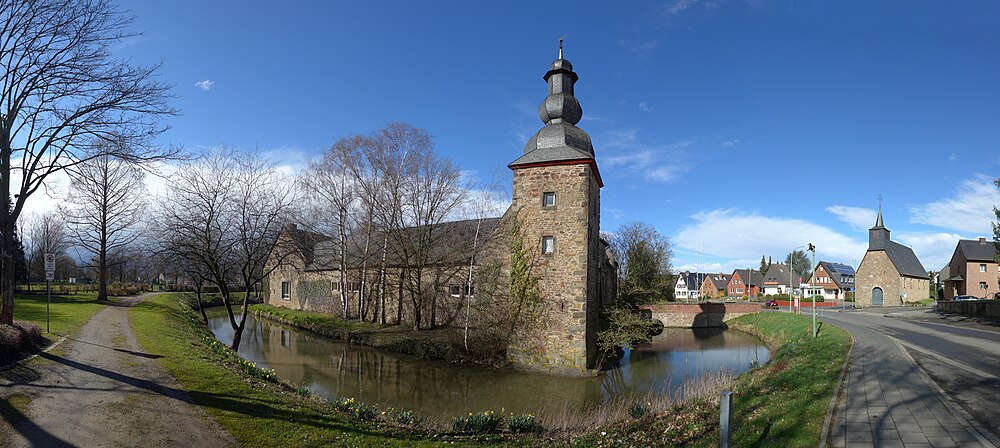Birgel Castle
| Birgel Castle | |
|---|---|
|
The eastern front of the castle |
|
| Creation time : | before 1271 |
| Castle type : | Niederungsburg |
| Conservation status: | Received or received substantial parts |
| Construction: | Quarry stone |
| Place: | Birgel |
| Geographical location | 50 ° 46 '20 " N , 6 ° 26' 43" E |
| Height: | 155 m above sea level NN |
The Burg Birgel is in Birgel , a district of Düren in the same district in North Rhine-Westphalia .
The castle is a four-wing complex made of rubble stones , which is surrounded by moats. The mansion blends in with the farm buildings in the northeast corner. The two-storey gateway is located on the eastern front .
The buildings were significantly destroyed in the Second World War . In 1957 the former community of Birgel acquired the castle. It was converted into a school and inaugurated on September 10, 1959. However, the complete expansion could not be completed until 1964. Due to the municipal reorganization in 1972, it came into the ownership of the city of Düren.
The family of von Birgel is mentioned for the first time in 1271, when Winnemar Frambach von Birgel was Marshal of Count von Jülich . The oldest evidence for Birgel is a document dated June 24th, 1301. Count Gerhard von Jülich left the "Haus Birgel" to Johann von Birgel, he was the nephew of the knight Anselm and for this he acquired the hereditary bailiwick of Düren. Parts of today's castle, for example in the large part of the substructure of the northern front, should be seen as the original foundation walls of this oldest castle building. Johann der (I) von Birgel belonged to the family of Jülich Marshal Winnemar Frambach, who was documented in 1269 and 1272. Until 1398, the hereditary marshal's office and property of the Birgel family remained in the hands of his descendants. Johann the Elder von Birgel later became heir to Haus Birgel. Perhaps he is identical to the person named with the same name as judge in Düren from 1404 to 1407 and a co-signer of the Jülich Land Peace of 1429. The last name bearer on Birgel was Johann von Birgel in 1558. He left three daughters. The youngest of them, named "Coda", married to Peter von der Ehren, was bequeathed by Birgel to her son Johann von der Ehren.
He rebuilt the destroyed castle and created the complex as it has been preserved from the ground plan to this day. He and his wife fell victim to the plague that raged in Düren in 1635. The only daughter Anna Veronika von Ehren married the Palatinate-Neuburg Chamberlain and Colonel Ernst von Boecop zu Ravensbergh. Both sons died without offspring. Birgel's heirs were the great nephews and not his wife, who sold Birgel to the lawyer Anton Ricker in 1733. Anton Ricker was a native of Düsseldorf, a lay judge in Düren from 1740 to 1750 and in 1758 also mayor of the city of Düren. In 1747/48 he sponsored the construction of the stone Rur Bridge with considerable funds from his private fortune.
His son, the Düsseldorf Canon Ricker, inaugurated the statue of St. John of Nepomuck, which was erected on the bridge, in 1753. The Düsseldorf banker Johann Theodor Hoffstad acquired the Birgel house from him. His son-in-law, Johann Arnold Leunenschloß, bought Birgel when he married in 1773. Johann Arnold Leunenschloß was a very respected businessman and in 1761 mayor of Düren.
Birgel was followed by his sons Johann Adolph and Johann Jakob Leunenschloß. They sold Haus Birgel to the mayor of Neuss, Clemens Zeno Sels, in 1786. After moving to Birgel, Sels often had the castle restored. Clemens Zeno Sels died in 1825 and in 1840 the industrialist Leopold Schoeller from Düren bought Birgel Castle from his heirs , which he only visited for summer festivals and hunts. His son Alexander Paul Schoeller, from 1885 the new lord of Burg Birgel, had a new mansion built in brick and the wooden drawbridge was replaced by a stone bridge.
His son Max Schoeller made the Birgel house his home after the death of his father in 1892. In 1913, after the death of his wife, he sold it with all its inventory and furniture to Leo Freiherrn von Diergardt. Even during the First World War, the castle suffered from constantly changing billeting. During the Second World War, the old house was completely destroyed and the roofs of the farm buildings were significantly damaged. After the Land Reform Act of 1949, Birgel was split up. the castle complex was acquired by the municipality of Birgel and from 1956 to 1964 - in sections - it was expanded as a school building for the Birgel primary school. The building has been home to Birgel's primary school since 1968. Since the reorganization in 1972, the city of Düren has owned the castle.
Today the Burg Birgel municipal community primary school is located in the building. Primary school students from Birgel, Kufferath and Berzbuir are taught here. The secondary school was also housed here until 1968.
literature
- Dietmar Mätschke: Birgel home book . Düren 1981.
- Christian Heiden: Birgel Castle and Village in the Past and Present . Düren 1965.
Web links
- Entry by Hans-Jürgen Greggersen zu Birgel near Düren in the scientific database " EBIDAT " of the European Castle Institute
- Primary school homepage
Individual evidence
- ↑ Dietmar Mätschke: Heimatbuch Birgel . Düren 1981, p. 245 .





